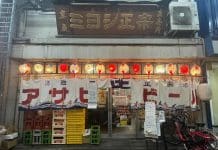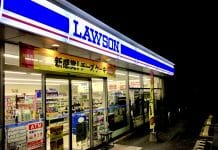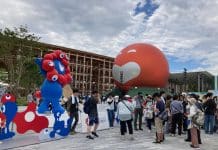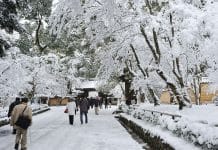Follow Kim Dunstan @kimosaka on Instagram
I first met artist and photographer Kim Dunstan on the Mixi social network site about 20 years ago. He went by the name Kim Osaka and only posted photos of his art, so I wrongly assumed he was Korean (which is often the case). I finally discovered he was an Australian with a French first name when I met him in person a year or so later. A mutual artist friend, Eri Moon, was doing printmaking in the same studio as he was, so she put us in touch in the real world. We became fast friends due to our mutual interests in art, photography, and the Showa Era in Japan.
I met up with him in November last year at 10w Gallery, a small gallery in Hiranomachi that specializes in erotic art, and is owned by a former Playboy Club waitress. We have both participated in several group shows at the gallery over the years, so it was a good place to catch up.

Why and when did you come to Japan?
I came to Japan in 1992 with a backpack and a working holiday visa and a year open air ticket to Paris. I came because I was interested in Japanese art, in particular wood block printing. I chose Osaka because friends who had lived in Japan said it had the best food and Kansai was more interesting than Kanto. I never used the ticket to Paris.

Was your art influenced by Japan before you arrived here?
Yes, I was always a printmaker, etching, screen printing, lino printing and wood block printing, so it was very natural to be influenced by the Ukiyoe of Japan. Also as well as the more well known woodblock prints of Japan as an artist who almost exclusively works with nudes I was particularly attracted to “Shunga” the traditional erotic artworks of Japan featuring woodblocks by all the well known classical artists of Japan, from Utamaro to Hokusai.

How did you begin making art in Japan? I remember a while ago you told me you studied under a famous wood block artist. What was his name?
I started at a print studio featuring woodblock and etching in Hyogo, helped by the artist and owner Fumi Gyobu.

Has Japan influenced your style? What brands are you wearing today?
Maybe. I have always been attracted by some Japanese brands and designers, Comme Des Garçons and Yoji Yamamoto. Today I am wearing a hat by Dry Bones Japan, a Schott NYC jacket, Japanese indigo dyed denim jeans by Edwin, and Dr. Martens boots. The t-shirt is my own brand, Nama-Tease.

What is the difference between how you approach printmaking and photography?
Actually the approach to the subject matter is pretty similar and all of printmaking starts from my photography. Once I have captured the images I want in the setting I have chosen then the two areas divert. Whereas in photography I am concerned with light and dark, and colour tones created by using up to ten strobes with coloured gels, in printmaking I focus totally on line. I am obsessed with the line of the body for example and for that reason I work primarily using the “Drypoint” technique in etching. Of course woodblock is all about the carved line too.

When did you first start showing your work at 10w? How did you discover the gallery?
I think it was in 2012 that I first exhibited. I discovered the gallery as a rare Osaka gallery that focused on erotica and interesting themed exhibitions and events with a great sense of humour and enthusiasm. This is totally because of the wonderful owner Akiko Sakai. I believe she saw my erotic etchings somewhere and invited me to join an exhibition.

So you decided to start putting your art and photography on t-shirts to establish Nama Tease? When did you begin the company?
We began in 2016.
Did you look to any particular advertising to give your shirts the Showa style?
Not consciously, but I am a collector of old Japanese magazines, so I am familiar with Taisho and Showa advertising.
What was your first shirt design?
It was the “Nama Beer” T-shirt. Followed very quickly by the “Nama Beer Amasan Diving Girls” T-shirt

Anyone who has seen your prints or art knows you love Amasan (pearl divers). What fascinates you about Amasan?
Firstly I grew up free diving in Australia and I became interested in Amasan after seeing the amazing photographs of Italian photographer Fosco Maraini and other even earlier photographs.
These women free diving wearing nothing more than a simple loin cloth seemed so unlike anything in modern Japan. And when I read about them and discovered that they were a totally matrilineal society within the traditional totally patriarchal society of Japan, I was instantly fascinated. The more I researched I realised that most Japanese people know nothing about them or simply know a rewritten history of them produced by prudish Mikimoto or an enforced pandering to foreign prudishness at the beginning of the tourist industry. This curtailing to foreigner prudishness is also what led to “Shunga” Japanese classical erotic art being hidden and even outlawed for so many years, which in turn has led to a total ignorance by many average Japanese people of their own history.

What is the best way to purchase art from you, or get info for upcoming exhibitions?
I guess direct contact through my Instagram site is the easiest for inquiring about art. But you can get a better feel for the art at exhibitions. My upcoming exhibition info is always posted to Instagram.

What are your plans for Nama-Tease’s future?
Sales are mostly online now, but it would be nice to have them in some shops in Japan. Though online on-demand sales are the most eco friendly. We have a wide variety of designs now and will always be adding new ones. Please have a look! https://namatease.com





















Nice one, John!